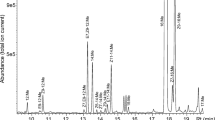Abstract
Males of the cerambycid beetle Xylotrechus pyrrhoderus release a mixture of (S)-2-hydroxy-3-octanone [(S)-1] and (2S,3S)-2,3-octanediol [(2S,3S)-2] as a sex pheromone that attracts conspecific females. The chemical structures of these pheromone components include a common motif and are assumed to be biosynthetically related. Here, we show that deuterated (S)-1, applied on the cuticle of a pronotal pheromone gland, was converted into (2S,3S)-2, that included deuterium atoms, but a reverse conversion did not take place. These results reveal a carbonyl reductase to be active in the pheromone gland, and that the ketol is a biosynthetic precursor of the diol. Males did not produce (R)-1; however, deuterated (R)-1 was converted into (2R,3R)-2, indicating an attack of the enzyme from the opposite side of the hydroxyl group at the 2-position. Furthermore, to understand the substrate specificity of the enzyme, racemates of 2-hydroxy-3-hexanone and 2-hydroxy-3-decanone were synthesized and applied to the gland. Their conversion into the corresponding diols suggests that the enzyme reduces the carbonyl group at the 3-position, regardless of the chain length.





Similar content being viewed by others
References
El-Sayed AM (2014) Internet database: http://www.pherobase.com/ Accessed 23 April 2014
Fettköther R, Dettner K, Schröder F, Meyer H, Francke W, Noldt U (1995) The male pheromone of the old house borer Hylotrupes bajalus (L.) (Coleoptera: Cerambycidae): identification and female resonse. Experientia 51:270–277
Hall DR, Cork A, Phythian SJ, Chittamuru S, Jayarama BK, Venkatesha MG, Sreedharan K, Kumar PKV, Seetharama HG, Naidu R (2006) Identification of components of male-produced pheromone of coffee white stemborer, Xylotrechus quadripes. J Chem Ecol 32:195–219. doi:10.1007/s10886-006-9360-0
Hanks LM, Millar JG (2013) Field bioassays of cerambycid pheromones reveal widespread parsimony of pheromone structures, enhancement by host plant volatiles, and antagonism by components from heterospecifics. Chemoecology 23:21–44. doi:10.1007/s00049-012-0116-8
Hanks LM, Millar JG, Moreira JA, Barbour JD, Lacey ES, McElfresh JS, Reuter FR, Ray AM (2007) Using generic pheromone lures to expedite identification of aggregation pheromones for cerambycid beetles Xylotrechus nauticus, Phymatodes lecontei, and Neoclytus modestus modestus. J Chem Ecol 33:889–907. doi:10.1007/s10886-007-9275-4
Iwabuchi K (1982) Mating behavior of Xylotrechus pyrrhoderus Bates (Coleoptera: Cerambycidae) I. Behavioral sequences and existence of the male sex pheromone. Appl Entomol Zool 17:494–500
Iwabuchi K (1986) Mating behavior of Xylotrechus pyrrhoderus Bates (Coleoptera: Cerambycidae) III. Pheromone secretion by male. Appl Entomol Zool 21:606–612
Iwabuchi K, Takahashi J, Nakagawa Y, Sakai T (1986) Behavioral responses of female grape borer Xylotrechus pyrrhoderus Bates (Coleoptera: Cerambycidae) to synthetic male sex pheromone components. Appl Entomol Zool 21:21–27
Iwabuchi K, Takahashi J, Sakai T (1987) Occurrence of 2,3-octanediol and 2-hydroxyl-3-octanone, possible male sex pheromone in Xylotrechus chinensis Chevrolat (Coleoptera: Cerambycidae). Appl Entomol Zool 22:110–111
Kiyota R, Yamakawa R, Iwabuchi K, Hoshino K, Ando T (2009) Synthesis of the deuterated sex pheromone components of the grape borer, Xylotrechus pyrrhoderus. Biosci Biotechnol Biochem 73:2252–2256. doi:10.1271/bbb.90348
Kuwahara Y, Matsuyama S, Suzuki T (1987) Identification of 2,3-octanediol and 2-hydroxy-3-octanone from male Xylotrechus chinensis Chevrolat as possible sex pheromones (Coleoptera: Cerambycidae). Appl Entomol Zool 30:25–28
Lacey ES, Ginzel MD, Millar JG, Hanks LM (2004) Male-produced aggregation pheromone of the cerambycid beetle Neoclytus acuminatus acuminatus. J Chem Ecol 30:1493–1507. doi:10.1023/B:JOEC.0000042064.25363.42
Lacey ES, Moreira JA, Millar JG, Ray AM, Hanks LM (2007) Male-produced aggregation pheromones of the cerambycid beetles Neoclytus muconatus muconatus. Ent Exp Appl 122:171–179. doi:10.1111/j.1570-7458.2006.00508.x
Lacey ES, Millar JG, Moreira JA, Hanks LM (2009) Male-produced aggregation pheromones of the cerambycid beetles Xylotrechus colonus and Sarosesthes fulminans. J Chem Ecol 35:733–740. doi:10.1007/s10886-009-9633-5
Mayo PD, Silk PJ, Cusson M, Béliveau C (2013) Steps in the biosynthesis of fuscumol in the longhorn beetles Tetropium fuscum (F.) and Tetropium cinnamopterum Kirby. J Chem Ecol 39:377–389. doi:10.1007/s10886-013-0260-9
Mitchell RF, Millar JG, Hanks LM (2013) Blends of (R)-3-hydroxy-2-one and alkan-2-ones identified as potential pheromones produced by three species of cerambycid beetles. Chemoecology 23:121–127. doi:10.1007/s00049-012-0122-x
Ray AM, Barbour JD, McElfresh JS, Moreira JA, Swift I, Wright IM, Zunic A, Mitchell RF, Graham EE, Alten RL, Millar JG, Hanks LM (2012) 2,3-Hexanediols as sex attractants and a female-produced sex pheromone for cerambycid beetles in the Prionine genus Tragosoma. J Chem Ecol 38:1151–1158. doi:10.1007/s10886-012-0181-z
Sakai T, Nakagawa Y, Takahashi J, Iwabuchi K, Ishii K (1984) Isolation and identification of the male sex pheromone of the grape borer Xylotrechus pyrrhoderus Bates (Coleoptera: Cerambycidae). Chem Lett 13:263–264
Schröder F, Fettkother R, Noldt U, Dettner K, Konig WA, Francke W (1994) Synthesis of (3R)-3-hydroxy-2-hexanone, (2R,3R)-2,3-hexanediol and (2S,3R)-2,3-hexanediol, the male sex pheromone of Hylotrupes bajulus and Pyrrhidium sanguineum (Cerambycidae). Liebigs Ann Chem 1211–1218. doi: 10.1002/jlac.199419941212
Zarbin PHG, Fonseca MG, Szczerbowski D, Oliveira ARM (2013) Biosynthesis and site of production of sex pheromone components of the cerambycid beetle, Hedypathes betulinus. J Chem Ecol 39:358–363. doi:10.1007/s10886-013-0252-9
Author information
Authors and Affiliations
Corresponding author
Rights and permissions
About this article
Cite this article
Iwabuchi, K., Arakawa, M., Kiyota, R. et al. Carbonyl Reduction in the Biosynthesis of a Male Sex Pheromone Secreted by the Grape Borer Xylotrechus pyrrhoderus . J Chem Ecol 40, 1146–1151 (2014). https://doi.org/10.1007/s10886-014-0508-z
Received:
Revised:
Accepted:
Published:
Issue Date:
DOI: https://doi.org/10.1007/s10886-014-0508-z




